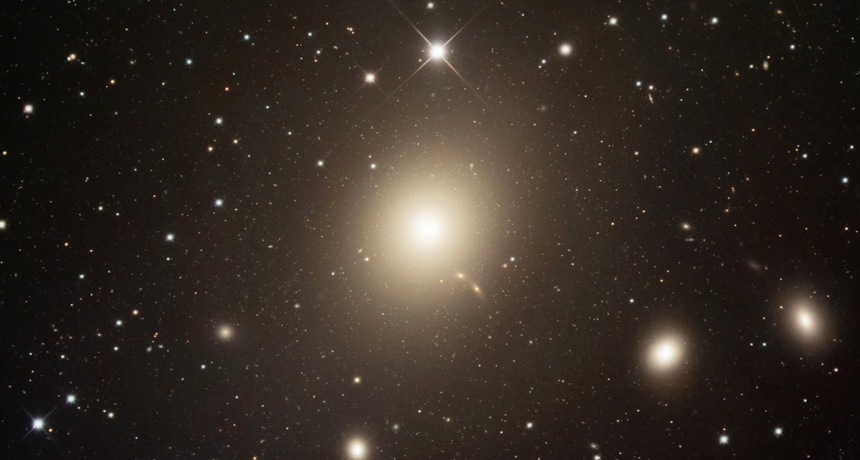Star cluster rockets through space
It’s the first time astronomers have ever detected a cluster of stars moving collectively at such speed

A compact cluster of stars is shooting out of this galaxy at almost 5 million miles per hour.
HUBBLE HERITAGE/NASA/ESA
Astronomers have detected the first massive, compact ball of stars moving as a group at hypervelocity (super-extreme speed). Called a globular cluster, this ball contains hundreds of thousands of stars. And it is moving so fast that it’s sailing out of its host galaxy. That extraordinarily massive galaxy, known as M87, sits 53 million light-years away. (It lies in the direction of the constellation Virgo.)
Nelson Caldwell of the Harvard-Smithsonian Center for Astrophysics, in Cambridge, Mass., and his colleagues have given the rocketing star cluster a quite unassuming name: HVGC-1. As you might guess, it stands for hypervelocity globular cluster number 1.
Caldwell’s group clocked the star cluster moving at roughly 8 million kilometers (almost 5 million miles) per hour. No one knows for sure what could have propelled this mega-cluster at such immense speed. But Caldwell’s team does have an educated guess: a supermassive binary black hole.
The term binary refers to the fact that this system would actually consist of two black holes closely orbiting each other. Astronomers have no direct evidence that such binary black hole systems exist, but they have reason to think they might. And such a pair at the center of M87 might have supplied enough oomph to have ejected HVGC-1 from its home.
Caldwell’s group described its finding on February 25 at arXiv.org.
Power Words
astronomy The area of science that deals with celestial objects, space and the physical universe as a whole. People who work in this field are called astronomers.
black hole A region of space having a gravitational field so intense that no matter nor radiation (including light) can escape it.
constellation Patterns formed by prominent stars that appear close to each other in the night sky. Modern astronomers divide the sky into 88 constellations, 12 of which (known as the zodiac) lie along the sun’s path through the sky over the course of a year. Virgo is one of those 12 zodiac constellations.
galaxy A massive group of stars bound together by gravity. Galaxies, which each typically include between 10 million and 100 trillion stars, also include clouds of gas, dust and the remnants of exploded stars.
light-year The distance light travels in a year, about 9.48 trillion kilometers (almost 6 trillion miles). To get some idea of this length, imagine a rope long enough to wrap around the Earth. It would be a little over 40,000 kilometers (24,900 miles) long. Lay it out straight. Now lay another 236 million more that are the same length, end-to-end, right after the first. The total distance they now span would equal one light-year.
velocity The rate of change in the position of some object, often called its speed. But speed and velocity are not always the same. Speed only refers to how quickly something is moving. For something to have velocity, it must continue to move away from some starting position. So even if something moves continuously and quickly, if it also constantly returns to its starting position (like a child running in a circle), it will have zero velocity.
star Thebasic building block from which galaxies are made. Stars develop when gravity compacts clouds of gas. When they become dense enough to sustain nuclear-fusion reactions, stars will emit light and sometimes other forms of electromagnetic radiation. The sun is our closest star.







